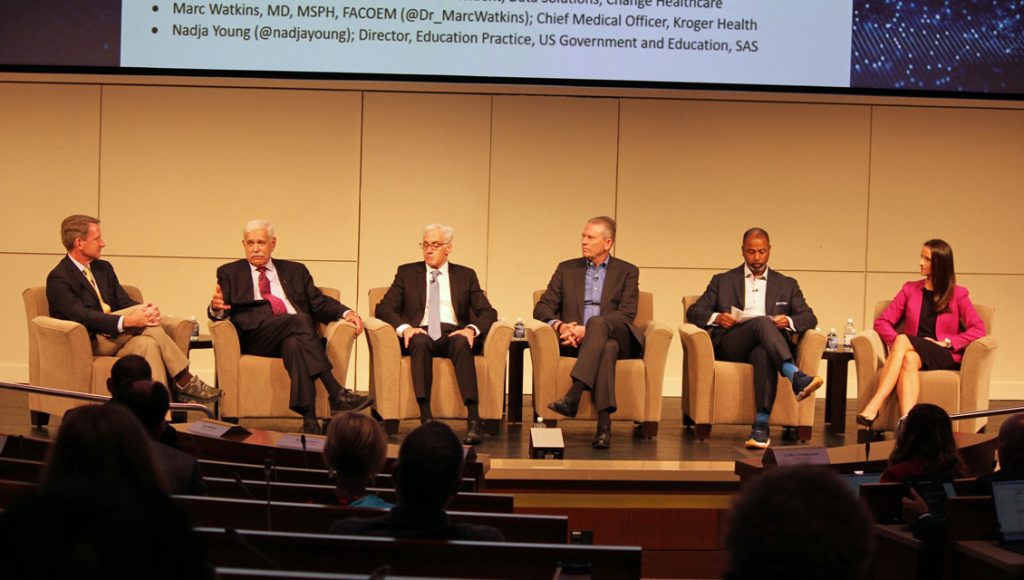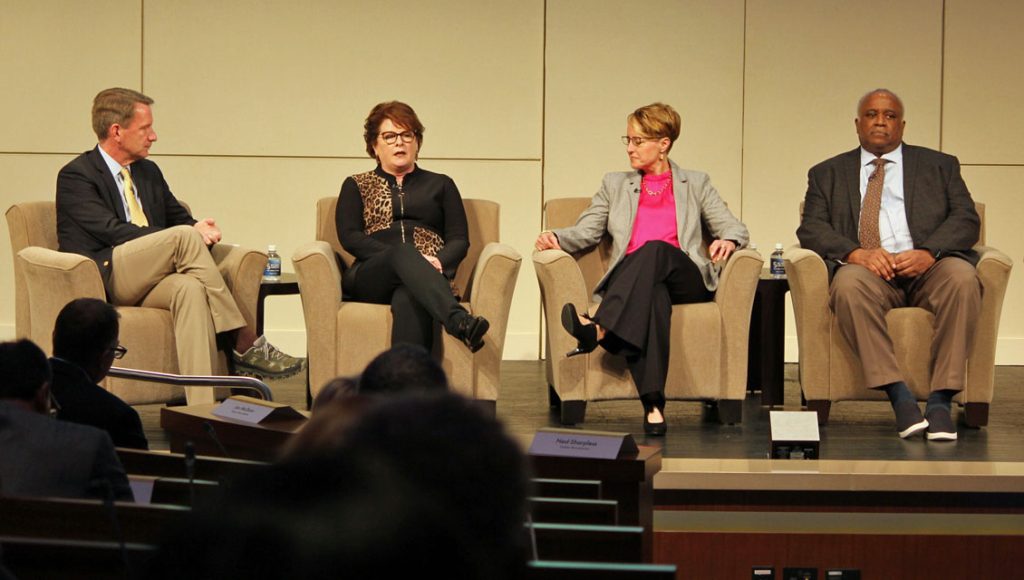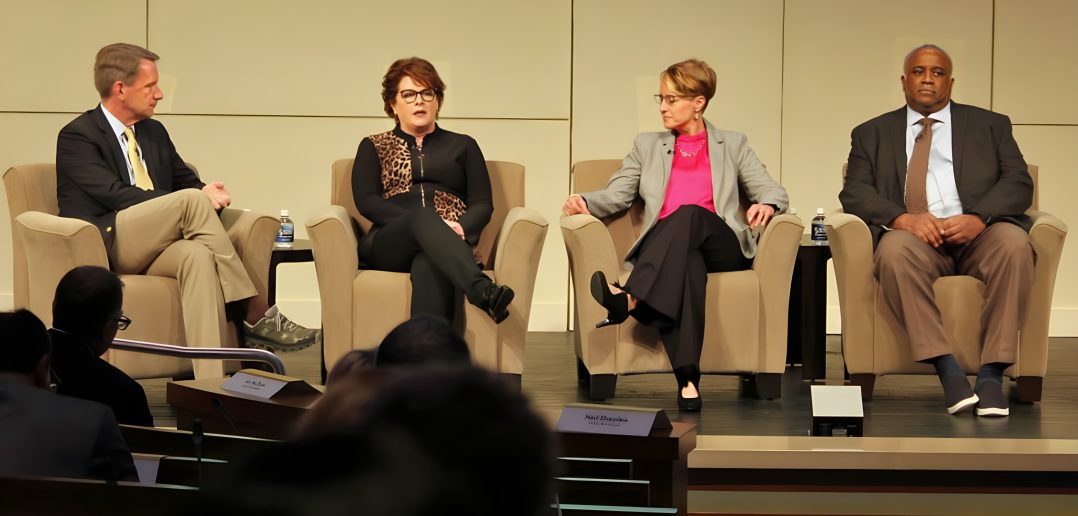What barriers do some communities face in getting the facts about cancer and the treatment they deserve? The CEO Roundtable on Cancer opened up about them at a November conference at SAS.
For 21 years, the CEO Roundtable on Cancer has been gathering to discuss advancements in cancer. Their 40-member organization, along with representatives from five US government organizations, share an ongoing mission to:
- Reduce the risk of cancer.
- Enable early diagnosis.
- Facilitate access to the best available treatments.
- Hasten the discovery of novel and more effective anti-cancer therapies.
SAS has played an active role with the organization since its beginning, with SAS CEO Jim Goodnight serving on its board. Goodnight also serves on the board of Project Data Sphere, the independent initiative of the CEO Roundtable on Cancer designed to provide a place where the world’s research community can share, integrate, and analyze patient-level data from academic and industry cancer clinical trials.
SAS is Gold Standard certified, committing to an evidence-based framework to provide a healthier workplace by focusing on cancer risk reduction, early detection and high-quality care. The company is also a partner in the Going for Gold program, which extends the CEO Cancer Gold Standard employer accreditation to recognize universities that champion health and well-being by advancing prevention, diagnosis, and quality treatment for cancer for their students, faculty, staff, alumni, parents, and communities.

Gail Stephens, Vice President, Health Care and Life Sciences, is among those who provide support for the research environments, serving in an advisory role to both organizations. Several members of her team were also on hand during the event to demo platforms and guide participants to helpful resources. “We feel honored to be part of such an important effort,” she said.
The focus of this year’s event, held Nov. 1-2 at SAS world headquarters, explored inroads to cancer prevention and treatment from a distinct angle: equitable access.
Education and community trust
Reducing cancer risk begins with education – knowing its causes, how to detect it and where to find resources and treatment. But for people to listen and learn, there must first be trust.
“The most important thing is to hear from people who are living in the gaps and find ways to partner to provide support and service,” said Jon McDunn, PhD and Executive Director of Evidence Generation Research and Strategic Alliance Development at Project Data Sphere.
Gary Puckrein, PhD, President and Chief Executive Officer of the National Minority Quality Forum, cited Henrietta Lacks, the Tuskegee experiment and historical acts of medical mistrust in calling for measures to rebuild confidence. “We need more Black people in analytics. In too many situations, HBCUs [Historically Black Colleges and Universities] are the afterthought. Until you start addressing those underlying issues, you’ll have trust issues,” he said.
Stephens believes there are opportunities for SAS employees get involved and help HBCUs and HSIs [Hispanic-Serving Institutions] enhance cancer prevention education within their schools. “That’s what the Gold Standard is all about,” she said. There is also a need to help HBCUs and HSIs establish or expand data science programs. “There are so many ways for SAS employees to contribute to this effort, particularly those who understand computer vision,” she said.
José Alberto Torres-Ruiz, PhD, Chancellor, Ponce Health Sciences University in Puerto Rico, offered additional ideas. “Recruit leaders from the community, particularly rural areas. Treat them as colleagues and offer them stipends. Include them in meetings. Change the stigma,” he said.
“We need people who will go out of their way,” said Nadja Young, Director of the SAS Education Practice. As an example, she shared the community-building practice of Dr. Robert Winn of Massey Cancer Center, which offers “Facts & Faith Fridays” – a podcast that pairs local pastors and medical experts to bring scientific conversations to the faith community.
“If Covid taught us anything, it’s that we cannot leave the community out of the conversation or something bad will happen,” said Puckrein.
Financial and insurance constraints
But education alone won’t be enough to effect change. Speakers agreed that financial challenges must also be addressed. In the US, for instance, the type of insurance an individual has determined the clinical trials they can access. Even if they are accepted into a trial, there can be cost-prohibitive factors such as transportation, time away from work and childcare.
“We can jump through all the hoops we want and create all these advanced treatments, but if we don’t figure out the insurance piece and equitable access to clinical trials, we’re not going to see the progress we need,” said Dana Dornsife, Founder and CEO, Lazarex Cancer Foundation.

The barriers to being financially challenged are multiple layers deep when participating in clinical trials, according to J. Leonard Lichtenfeld, MD, MACP, Chief Medical Officer, Jasper Health. “Getting them in the door, keeping them in the door, and providing them the care and resources they need throughout is a struggle on so many levels,” he said.
Often triggered by financial constraints, late diagnosis is also an equity issue for minority populations. To illustrate, Puckrein talked about an early screening test that detects 50 different cancers but costs $900. “Ten years from now, we could have a population where we have people walking around with tumors who are poor and people walking around without tumors who are affluent,” he said. “We want to bring all populations along.”
Professional workforce challenges
“If you’ve tried to get an appointment with an oncologist, you know it’s a challenge right now,” said Torres-Ruiz. Access to cancer center services, particularly in remote areas, can also be trying.
“The field has become very difficult,” said Elisabeth Heath, MD, Associate Center Director of Translational Sciences and leader of the Genitourinary Oncology Multidisciplinary Team at Karmanos Cancer Institute. “Practitioners graduate with only about 30 percent of their toolkit now. There’s something new coming out every day for them to learn and absorb, and practitioners have their own mental health to consider.”
Staffing challenges are even greater in minority communities. “It’s hard to see yourself as a cancer clinician if you have never seen someone like you in that role. But we need the underserved population to join the cancer research and clinical treatment workforce,” said Susanna Greer, PhD, Chief Scientific Officer of The V Foundation for Cancer Research.
That introduces challenges of its own, according to Cynthia Warrick, PhD, President of Stillman College. “Our students are often paying for school, sending money back home and trying to keep up with their studies,” she said. “You don’t find that across all college campuses.” She called for all Roundtable members to offer data analytics internships to HBCU and HSI students, an action SAS is already pursuing.
Data and research
Panelists agreed that answers to cancer can be found in the data, particularly since many cancers are highly predictive – often down to the geographic area. Puckrein believes that kind of data provides an understructure worth tapping into. “How do we get to the point where we control cancer rather than cancer controlling us? The data is there to do it,” he said. Puckrein believes we’re at “the beginning of the end of the war on cancer” and need deep collaboration to manage it successfully.
SAS-funded Project Data Sphere LLC is a big part of that collaboration. Launched in 2014 with nine data sets, the platform currently features about 155 data sets representing more than 120,000 patient lives. Access to data sets is granted through a quick process, and various SAS analytic tools are freely available to registered users.
“Kroger captured over 320 million unique types of health care visits in 2021 alone. We’re able to model down to the community level,” said Marc R. Watkins, MD, Chief Medical Officer, Kroger Health. “With that, we can begin to understand and provide precision. We have to do it with data, and it has to be personal.”
But it won’t happen without people working together. “There are just some things you can’t do yourself, and research is clearly one of them,” said Tim Suther, MD, Senior Vice President of Data Solutions, Change Healthcare.
“Community engagement gets us to the next level,” said Heath. “[The Roundtable] is our community, and I hope we continue the conversation and work.”
What’s next for SAS and the CEO Roundtable on Cancer?
SAS is a technology stakeholder in a new PDS-powered Images and Algorithms program and pharma consortium to develop state-of-the-art AI algorithms to automate RECIST and markedly reduce inter-radiologist variability. The two primary objectives of this project are to:
- Develop AI for Total Tumor Volume (autoVOL).
- Automate RECIST-1.1 (autoRECIST).
“This is such important work and a true strength of SAS,” Stephens said. “I see so many opportunities.”


